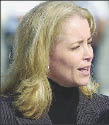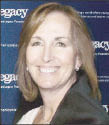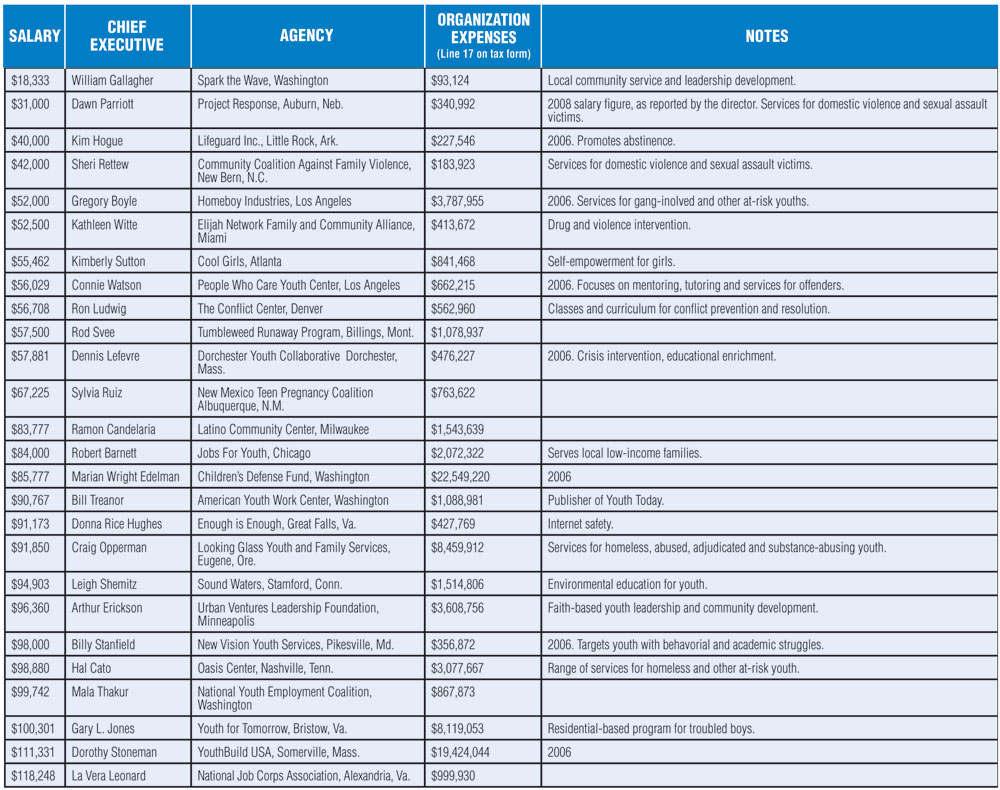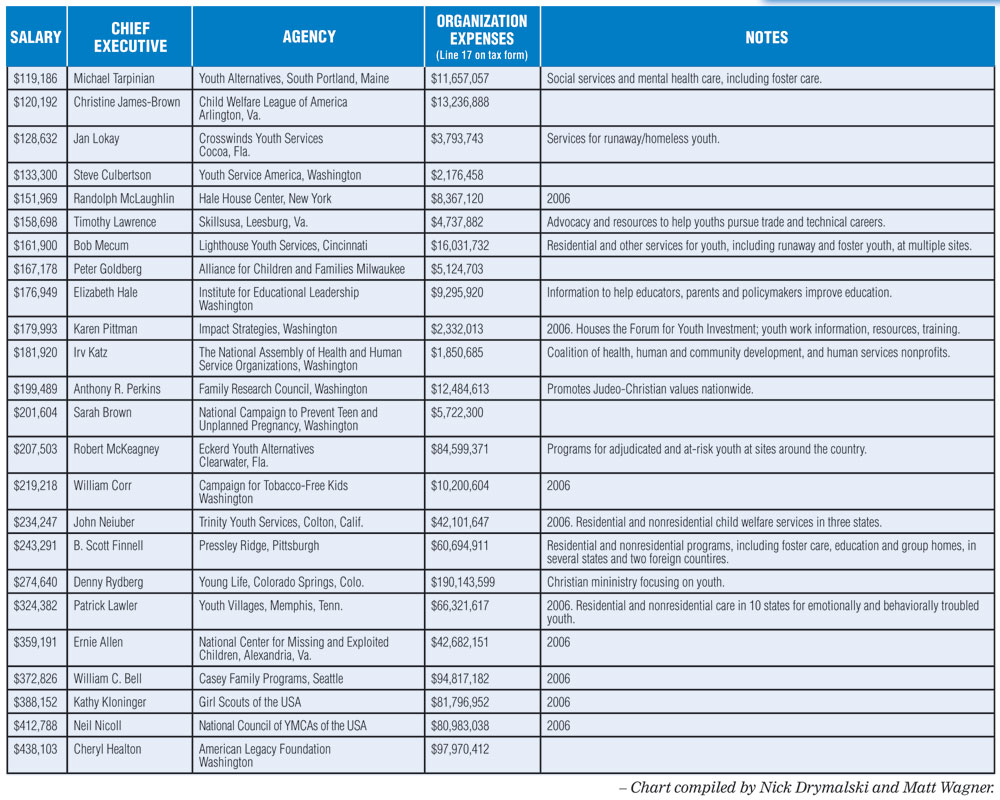“I’m guessing you don’t have too
 |
|
Robert Barnett $84,000 |
 |
|
Donna Rice Hughes $91,173 |
many people wanting to
 |
|
Billy Stanfield $98,000 |
talk about this,” says B. Scott Finnell, CEO of Pressley Ridge, a residential and community-based nonprofit based in Pittsburgh.
He means executive pay, and he’s right.
But with the CEOs at business behemoths like Ford and Freddie Mac getting flogged over eye-popping salaries while their companies wobble and employees get axed, one wonders how top executives across the youth field would fare under the same scrutiny (scroll down for a comprehensive chart listing salaries).
 |
|
Steve Culbertson $133,300 |
 |
|
Peter Goldberg $167,178 |
 |
|
Randolph McLaughlin $151,969 |
Youth Today’s informal sampling of salaries among 50 youth-focused nonprofits indicates that most have little to fear.
The salaries of CEOs, executive directors and president s reflect at least two facets of the youth work field: the wide variety of nonprofits involved, and the low pay ceiling at most of them.
Salaries ranged from $18,333 for William Gallagher at Spark the Wave, a skills training program in Philadelphia and Washington, to $438,103 for Cheryl Healton at the American Legacy Foundation, which funds programs around the country. (That’s not counting the occasional chief executive who forgoes
 |
|
William Bell $372,826 |
 |
|
Christine James-Brown $120,192 |
 |
|
Ron Ludwig $56,708 |
salary, at least for a while.)
Did someone just say “apples and oranges”? Yes, these leaders oversee organizations of different sizes and purposes. Think of this not as a comparison for judgment purposes, but as one snapshot of the youth field’s financial status.
Scanning through the salaries of the field’s leaders also puts faces on the factors behind executive pay.
How Much Is Right?
 |
|
Ramon Candelaria $83,777 |
 |
|
B. Scott Finnell $243,291 |
 |
|
Bill Treanor $90,767 |
The Youth Today sample sought variety in agency mission, location and size. It includes national organizations, stand-alone local programs, faith-based groups, direct service providers and funders.
The financial information on the accompanying chart is based on agencies’ 2007 federal tax returns, unless otherwise stated in the “notes” column. The chart does not include other salaries for related work. A few of the chief executives are no longer with the agencies.
Here are some of the factors behind the numbers:
 |
|
Hal Cato $98,880 |
 |
|
Craig Opperman $91,850 |
 |
|
Dorothy Stoneman $111,331 |
Size
Six-figure salaries are related to other big numbers: larger and more varied programs, larger operating budgets, more clients, more sites and more employees. Not surprisingly, the 2008 national executive compensation report issued by the Alliance for Children and Families – which is made up of 350 human services organizations – shows that agencies with at least 400 employees have the highest average CEO salaries.
At Pressley Ridge, Finnell ($243,000) oversees a well-known agency with programs for at-risk youth in eight states, as well as Hungary and Portugal. It has about 1,200 employees. Yet Yvonne English Roebuck, director of marketing and communications at Pressley Ridge, notes
 |
|
Anthony R. Perkins $199,489 |
that Finnell isn’t
 |
|
Sheri Rettew $42,000 |
 |
|
Irv Katz $181,920 |
even the highest paid employee there; at the time of the survey, two psychiatrists were.
Since the passage in 2002 of the federal Sarbanes-Oxley Act for corporate accountability, more scrutiny has been brought to bear on salaries at charities. Boards are under increasing pressure to set executive salaries that are comparable to those at similar nonprofits. The IRS requires this of organizations with tax-exempt status.
“There’s nothing that receives much more scrutiny in our organization than my salary,” Finnell says.
Geography
At Project Response in Auburn, Neb., Executive Director Dawn Parriott comes in near the low end of the pay scale, at $31,000. The project provides services to victims of domestic violence in five counties.
Parriott has been at the organization for 15 years, but is comfortable with the economic realities of southeastern Nebraska. “You’re not going to get rich here,” she says, “but … our living expenses aren’t as high as other places.”
The alliance survey reports what it calls a “modest” salary bump for CEOs working for organizations in the Northeast, where average operating budgets are higher as well.
Agency Income
 |
|
Cheryl Healton $438,103 |
 |
|
Karen Pittman $179,993 |
While agencies that have more money usually pay more, that doesn’t tell the whole story.
The percentage of an organization’s operating budget that is dedicated to a CEO’s salary is a commonly used marker of fairness. According to a recent study by Charity Navigator, a Web-based evaluator, CEO compensation among the 5,000-plus public charities in its database averages 3.32 percent of what the organization spends. (The surveyed organizations had garnered more than $500,000 in public support.)
But such figures are difficult to apply across the board. Consider American Legacy, where the 2006 budget was more than $100 million. (Legacy was formed and funded in 1999 by the Tobacco Master Settlement Agreement with 46 states, to provide public education about the dangers of smoking.) CEO Healton’s salary is the highest on the Youth Today survey, but it stood at about 0.45 percent of her organization’s budget.
Consider also Young Life, a Christian-based youth ministry based in Colorado Springs, Colo. CEO Denny Rydberg drew $274,640 – a lot more than most CEOs in the sample, but just 0.14 percent of the organization’s 2006 budget.
At small agencies, a CEO’s pay might take up a larger percentage of an agency’s budget, especially when the executive plays an all-hands-on-deck role with few other administrative employees. So at Spark the Wave, Gallagher’s comparatively meager salary of $18,333 took up more than 19 percent of the agency’s budget in 2006.
Longevity
 |
|
William Gallagher $18,333 |
 |
|
John Neiuber $234,247 |
 |
|
Sarah Brown $201,604 |
Sticking around helps. Bob Mecum has been with Lighthouse Youth Services in Cincinnati for 33 years. He began as director of what was then the Lighthouse Runaway Shelter at about $30,000 – “a damn good salary in the 1970s,” he says.
The organization has grown significantly, now running more than 20 programs with a budget of over $16 million and about 390 employees. CEO Mecum made $161,900 in 2006.
“I’m the beneficiary of the most powerful force in the universe,” he jokes. “Compound interest.”
Mission and Respect
 |
|
Gregory Boyle $52,000 |
 |
|
Marian Wright Edelman $85,777 |
Foundations tend to pay top executives much more than direct-service groups do, especially if they hire from corporations or universities. (At Legacy, Healton is long-time professor at Columbia University’s School of Public Health.) Of her relative low salary, Parriott of Project Response states matter-of-factly, “I believe in the mission.”
Such motivation isn’t the only reason youth-work CEO salaries remain low. Deborah Craig, project manager of the Next Generation Youth Work Coalition, says it’s about lack of respect for the field.
“Until we can define ourselves clearly,” Craig says via e-mail, “front-line youth workers all the way up through executive leadership will struggle to be respected in the broader community, recognized and financially rewarded.”
 |
 |






























